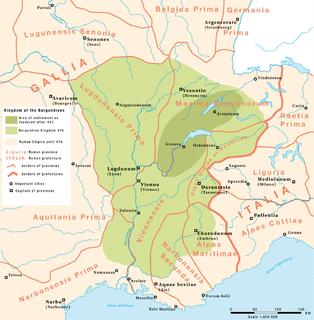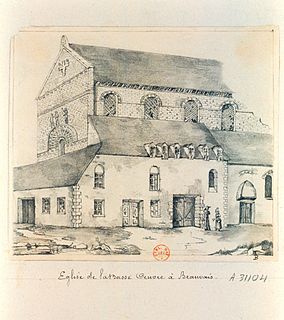Isembard (also spelled Isembart or Isembert) was a Burgundian nobleman and count of Autun. According to the Annales Fontanellenses , his father was Warin of Provence. [1]

Kingdom of Burgundy was a name given to various states located in Western Europe during the Middle Ages. The historical Burgundy correlates with the border area of France, Italy and Switzerland and includes the major modern cities of Geneva and Lyon.
Guerin, Garin, Warin, or Werner was the Count of Auvergne, Chalon, Mâcon, Autun, Arles and Duke of Provence, Burgundy, and Toulouse. Guerin established the region against the Saracens from a base of Marseille and fortified Chalon-sur-Saône (834). He took part in many campaigns during the civil wars that marked the reign of Louis the Pious and after his death until the Treaty of Verdun (843). The primary sources for his life are charters and chronicles like the Vita Hludovici.
In 850, Isembard and Count Aledramn of Barcelona were sent by King Charles the Bald to subdue the rebellious Margrave William of Septimania. [1] They were both captured through a ruse. [2] On 21 March 858, at the synod of Quierzy, Isembard was one of the lay magnates who swore fidelity to King Charles. [3] He was thus probably one of the "leading men of Burgundy" whom the Annales Bertiniani record as joined Charles at Brienne and Chalon that November, when he and Louis the German almost came to battle.

Charles the Bald was the King of West Francia (843–877), King of Italy (875–877) and Holy Roman Emperor. After a series of civil wars during the reign of his father, Louis the Pious, Charles succeeded by the Treaty of Verdun (843) in acquiring the western third of the Carolingian Empire. He was a grandson of Charlemagne and the youngest son of Louis the Pious by his second wife, Judith.
William of Septimania was the son of Bernard and Dhuoda. He was the Count of Toulouse from 844 and Count of Barcelona from 848.
Annales Bertiniani are late Carolingian, Frankish annals that were found in the Abbey of Saint Bertin, Saint-Omer, France, after which they are named. Their account is taken to cover the period 830-82, thus continuing the Royal Frankish Annals (741–829), from which, however, it has circulated independently in only one manuscript. They are available in the Monumenta Germaniæ Historica and in a later French edition taking into account a newly discovered manuscript . The Annals of St. Bertin are one of the principal sources of ninth-century Francia, and are particularly well-informed on events in the West Frankish sphere of Charles the Bald. The Annales Fuldenses are usually read as an East Frankish counterpart to their narrative.
On 20 June 859, Isembard (or possibly his son), described as a fidelis (loyal follower) in the charter, received a villa in the Narbonnais from the king, to be held in perpetuity (in proprium aeternaliter) as an allod. [4] [5] In 864, Isembard (or possibly his son again) was a royal missus and the viscount of Narbonne. The appointment of a royal fidelis to the office of viscount demonstrates that at this stage in Charles's reign, the king still coveted influence at the local level even in the far south of his realm. [5]

A villa was originally an ancient Roman upper-class country house. Since its origins in the Roman villa, the idea and function of a villa has evolved considerably. After the fall of the Roman Republic, villas became small farming compounds, which were increasingly fortified in Late Antiquity, sometimes transferred to the Church for reuse as a monastery. Then they gradually re-evolved through the Middle Ages into elegant upper-class country homes. In modern parlance, "villa" can refer to various types and sizes of residences, ranging from the suburban semi-detached double villa to residences in the wildland–urban interface.
An allod, also allodial land or allodium, refers, in the law of the Middle Ages and early Modern Period and especially within the Holy Roman Empire, to a freehold estate in land over which the allodial landowner (allodiary) had full ownership and right of alienation.
A missus dominicus, Latin for "envoy[s] of the lord [ruler]" or palace inspector, also known in Dutch as Zendgraaf, meaning "sent Graf", was an official commissioned by the Frankish king or Holy Roman Emperor to supervise the administration, mainly of justice, in parts of his dominions too remote for frequent personal visits. As such, the missus performed important intermediary functions between royal and local administrations. There are superficial points of comparison with the original Roman corrector, except that the missus was sent out on a regular basis. Four points made the missi effective as instruments of the centralized monarchy: the personal character of the missus, yearly change, isolation from local interests and the free choice of the king.
This page is based on this
Wikipedia article Text is available under the
CC BY-SA 4.0 license; additional terms may apply.
Images, videos and audio are available under their respective licenses.

Neustria, or Neustrasia, was the western part of the Kingdom of the Franks.

Judith of Flanders was queen consort of Wessex and countess consort of Flanders. She was the eldest daughter of the West Frankish King and later Holy Roman Emperor Charles the Bald and his wife Ermentrude of Orléans. Through her marriages to two Kings of Wessex, Æthelwulf and Æthelbald, she was twice a queen. Her first two marriages were childless, but through her third marriage to Baldwin, she became the first Countess of Flanders and an ancestor of later Counts of Flanders. One of her sons by Baldwin married Ælfthryth, a daughter of Æthelbald's brother, Alfred the Great. She was also an ancestor of Matilda of Flanders, the consort of William the Conqueror, and thus of later monarchs of England.

Bruno, also called Brun or Braun, a member of the Ottonian dynasty, was Duke of Saxony from 866 until his death. He is rated as an ancestor of the Brunonids, a cadet branch of the Ottonians, though an affiliation is uncertain. Bruno was killed fighting against Norse warriors in the Battle of Luneburg Heath and is venerated as one of the Ebsdorf Martyrs.
Fulk the Venerable was the Archbishop of Reims from 883 until his death. He was the chief opponent of the non-Carolingian king of France, Odo, in the last quarter of the 9th century. He was the brother of Anscar I, Margrave of Ivrea

Drogo, also known as Dreux or Drogon, was an illegitimate son of Frankish emperor Charlemagne by the concubine Regina.

Verberie is a commune in the Oise department in northern France.
Hugh was the count of Tours and Sens during the reigns of Charlemagne and Louis the Pious, until his disgrace in February 828.
Humfrid was the Count of Barcelona, Girona, Empúries, Roussillon, and Narbonne from 858 to 864. He also bore the title Margrave of Gothia, as he held several frontier counties.
Renaud (795–843) was Frankish Count of Herbauges, Count of Poitiers and Count of Nantes. His name is also spelled Rainaldus or Ragenold, and he is sometimes known as Reginald in English. He is referred to as Renaud of Aquitaine, but seems to have been a member of the Rorgonid family of Maine.
Ragenar was the bishop of Amiens from 830 to 833 and again from 834 until his death in 849. His predecessor, Jesse, was initially deposed by the Emperor Louis the Pious in 830 for conspiring with his rebellious son Lothair. In 833 he was restored when Lothair forced his father to make public obeisance at an assembly in Soissons. When Louis regained his position in 834, Jesse was again deposed and this time exiled to Italy, where he died in 836.

Odo I was a West Frankish prelate who served as abbot of Corbie in the 850s and as bishop of Beauvais from around 860 until his death in 881. He was a courtier and a diplomat, going on missions to East Francia and the Holy See.
The First Battle of Andernach between the West Frankish king Charles the Bald and the East Frankish king Louis the Younger took place on 8 October 876 near Kettig southeast of Andernach and resulted in Charles' complete defeat.
Engelram was Chamberlain to Charles the Bald through sometime after 871. He also held the title of count from 853, but it is unclear what his domain was. Nothing is known about his ancestry. Engelram's daughter was the first wife of Ricwin, Count of Verdun, and mother of Otto, Count of Verdun.
The Capitulary of Servais was the implementation of an agreement between Charles the Bald and his half-brother Lothar to maintain the peace. In a conference of Charles and Lothar at Valenciennes in 853, the missi [literally, the sent ones] were re-established after a long hiatus. Lothar recommended that peace and justice be secured by sending out missi to enforce the laws and help keep the peace. The Diet of Servais confirmed the decisions arrived at during the conference. The Capitulary of Servais was enacted by Charles in November 853 dividing the Franco-Burgundian portion of Charles’ realm into twelve districts (missatica) to enforce the measures of this agreement. According to Nelson, the twelve missicati and associated missi were:
Hugues, Viscount of Châteaudun, son of Geoffrey I, Viscount of Châteaudun, and Ermengarde. Virtually nothing is known about his life.
Raganar , Frankish Count. Raganar was a vassal of Charles the Bald and fought in many of Charles' campaigns. The precise counties that Raganar ruled are uncertain but are known to have been south of Thérouanne.
The royal household of the early kings of the Franks is the subject of considerable discussion and remains controversial. This discussion is aimed at identifying the major categories of participants in the administration and those who made the major historical impacts. Every king of the Franks from Clovis I to Charles the Bald had a large cadre of advisors and bureaucrats that helped implement their regime. These supporters of the crown are frequently unknown, but often are ancestors of the later rulers of France. This is not intended to be a complete list of those supporting the kings but to serve as a guide for further study. A general discussion of the Merovingian and Carolingian dynasties can be found in the associated main articles. See also Government of the Carolingian Empire.








